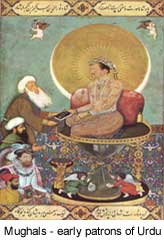

 |  |
The grammatical structure of Urdu is based on Western Sauraseni Apabhramsa but its vocabulary, idioms and literary traditions drew heavily from Central Asian, Turkish and Persian sources. The literary flowering of Urdu does not go farther than 13th century. Urdu literature developed in the bazaar, the monastery and the salons and all these places have their characteristic features. The early islamic rulers and the Mughals were the early patrons of Urdu literature .  The traditional Urdu poetry comprises of few literary genres that have a definite history and development. They are the Masnavi (every couplet has a different rhyme), Ghazals (talking to the tender sex), Gasida (a genre akin to the ode), Marsia (elegiac poem), Rekhti and Nazm. The early stages of the development of Urdu was a two pronged movement
The literary precedence of the south over the north can only be understood under the historical context. Sultan Ala-ud-din Khilji invaded the south during 1294-1311 A.D. The cultural confluence was responsible for the production of good literature in the south. The earliest known writer in Deccani Urdu is Sheikh Ganjulilm (b.1393). The next notable figure is Khwaja Banda Nawaz (1320-1422). His Mirajul Ashiqeen is a Sufistic treatise in prose. Other Masnavi writers are Mukimi of Bijapur and Ahmed Aziz. The Persian tradition has taken root in Urdu poetry in the 17th century. Mulla Wazhi is a great literary figure of this period. His Masnavi, Qutb Mustari (1609) and his rhyming prose allegory Subras (1634) are the gems of Urdu literature, in the Deccan. The Masnavi now yielded place to the Ghazal. Ghazal gave great poets like Amir Khusrau, Hashmi and Qutb Shah Wali. They further standardized the diction. The more important among them are Khwaja Mir Dard, Mir Hasan, Mushafi. There is also the Lucknow School of poets who made their own valuable contribution to Urdu poetry. The major poets are Sheikh Imam Baksh Nasikh, Haider Ali Atas and Ali Ausat Rask. Traditional Urdu poetry reaches its pinnacle with the verses of Ghalib. During the last three decades of the 19th century, the activities of Urdu poetry were influenced by the towering personality of Syed Ahmed Khan (1817-98) who started the Aligarh movement inspired by Raja Rammohan Roy. Many Urdu poets were influenced by Iqbal (1875-1938). Urdu fiction is rich in Dastan (cycles of legends) mostly translated from Persian. The works of Sharshar, Nazir Ahmed and Sharar marked the beginning of the novel. Ruswa's Umrao Jaan Ada (1899), a novel appearing in the form of an autobiography of a dancing girl of Lucknow has achieved international standards. Prem Chand, who is claimed also by Hindi is a giant among Urdu novelists. Drama also has flouroished considerably in Urdu. Banarsi, Talib, Ahsaan and Lakhnavi are famous as playwrights. Hussain Azad's anecdotal history of Urdu poetry titled Abe Hayat has laid the foundation of modern literary criticism. |
Copyright ©2000 indiansaga.info. All rights reserved.
By using this service, you accept that you won't copy or use the data given in this website for any commercial purpose.
The material on indiansaga.info is for informational & educational purpose only.
This site is best viewed at 800 X 600 picture resolution.